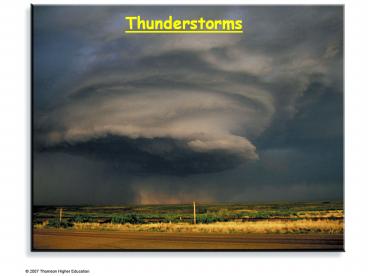Thunderstorms - PowerPoint PPT Presentation
Title:
Thunderstorms
Description:
Slide 1 ... Thunderstorms – PowerPoint PPT presentation
Number of Views:234
Avg rating:3.0/5.0
Title: Thunderstorms
1
Thunderstorms
2
Chapter 13 review
- A persistence forecast is a prediction that
future weather will be the same as the present
weather, whereas a climatological forecast is
based on the climatology of a particular region.
A steady-state forecast assumes the weather
systems will continue to move in the same
direction and at the same speed as they have been
moving so far. - Weather forecasts for up to a few hours are
called very short-range forecasts those that
range from about 6 hours to a few days are called
short-range forecasts medium-range forecasts
extend from about 3-5 days into the future,
whereas long-range forecasts extend beyond, to
about 8.5 days. - Seasonal outlooks provide an overview of how
temperature and precipitation patterns may
compare with normal conditions. - For a forecast to show skill, it must be better
than a persistence forecast or a climatological
forecast. - Predicting the movement of weather systems
- Steady-state method
- Lows (Highs) towards the greatest pressure drop
(rise) - In the direction of the winds aloft (5500 m)
3
Examples
4
Thunderstorms
- Storm with lightning and thunder. Also heavy
precipitation, sometimes hail, gusty surface
winds. - Favorable conditions
- Unstable atmosphere
- Strong convection (convective storm)
- Buoyant force the force on a less-dense
- object immersed in a denser environment
- Trigger for the convection
- Weather fronts - fast uplift of warm air
- Unequal surface heating
- Surface convergence and divergence aloft
- Topographic barriers
- Arrival of cold air aloft
5
Ordinary (Cell) Thunderstorms
- Also Air mass thunderstorms, pop-up
thunderstorms. - Typically they form where the surface converging
winds have no significant change of either
strength or direction with height (limited wind
shear). What goes up comes back down in the same
place. - Typical summer afternoon thunderstorms
- Last no more than an hour
- Extend no more than a kilometer
- Rarely produce strong winds or large hail
6
Stages of Development - I
- Cumulus (growth) stage
- Updraft warm and moist air is uplifted, expands,
condenses and forms towering clouds. - Latent heat is released -the temperature in the
cloud is higher than outside the cloud, air keeps
rising. - The updrafts are strong so that the cloud
droplets remain suspended in the cloud. - Usually no precipitation and lightning during
this stage.
7
Stages of Development - II
- Mature stage
- Precipitation starts
- Entrainment dry air from around the cloud is
drawn into the cloud. Some of the cloud droplets
evaporate and chill the air. - Downdraft the cold and heavy air is sinking
- The updraft and the downdraft form a storm cell.
- Gust front the boundary between the cold and the
warm air at the surface - Lightning and thunder
8
Stages of Development - III
- Dissipating stage
- the updraft weakens
- the gust fronts move away
- the precipitation is light
- the downdrafts dominate cut off the fuel supply
of the storm
9
Multicell Storms
- The downdraft from the dissipating storm fuels
the formation of next storm cell.
10
Multicell storm complex example
11
Severe Thunderstorms
- At least one of the following
- Large hail precipitation
- strong wind gusts
- tornadoes..
- The longer a storm lasts the grater the chance
for it to become a severe storm. Often forms
along a weather front. - They typically form if strong vertical wind shear
(large changes of the wind with height) is
present. The warm air updraft is not suppressed
by the downdraft and the precipitation.
12
Shelf cloud
13
Roll Cloud
14
(No Transcript)
15
(No Transcript)
16
(No Transcript)
17
(No Transcript)
18
Supercell thunderstorms
- Supercell storm consists of a single violently
rotating updraft - Favorable conditions when the speed and
direction of the winds aloft change with height - formation of a rotating updraft
- Updraft and downdraft do not cross -gt the storm
lives on for hours - Often produce large hail, damaging surface winds,
tornadoes
A supercell thunderstorm with a tornado sweeps
over Texas
Skip the discussion around Figs. 14.6 and 14.7
19
Squall Lines and MCCs
- Squall line A line system of thunderstorms. It
shows as a line of storms on the radar images. - It forms along or in front of an advancing cold
front. - Pre-frontal squall lines may be due to gravity
waves - Mesoscale convective systems a large circular
cluster of storms
20
Thunderstorm Movement
- The storms typically move in the direction of the
winds aloft (middle troposphere). - Some move at 30 deg to the right of the winds
aloft. (Effect of surface friction). - In general the multicell storms move in the
direction where the humid and unstable conditions
in the atmosphere prevail. - The squall line storms move in the direction of
the front movement.
21
Flooding
- Flash floods floods which rise rapidly with
little or no advance warning - Conditions the influx of water into an area is
more than the amount of water that can drain away
from the region. - The ground is saturated from a prolonged rainy
season - Very strong precipitation over a short time
period - Not so strong precipitation but for an extended
time- storms reoccur at the same location
(training). - Stationary weather fronts can result in a series
of thunderstorms over the same region.
22
(No Transcript)
23
Thunderstorm Climatology
- Most thunderstorms occur in Florida
- Unstable atmospheric conditions (warm and moist
surface air) prevail throughout the year. - Summertime afternoon air mass thunderstorms.
- Most severe thunderstorms occur in the Great
Planes. - The warm (unstable) air is dry and shallow and
the ice crystals do not have time to melt.
Stormy days / year
Days with hail / year































